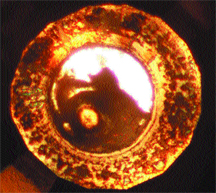 New research
is expanding the range of the formation of fossil fuels. Experiments in the
laboratory have produced abiogenic methane — gas not produced by living
organisms — at temperatures and pressures similar to that of the upper
mantle. The findings could change the way scientists view hydrocarbons on this
planet and others.
New research
is expanding the range of the formation of fossil fuels. Experiments in the
laboratory have produced abiogenic methane — gas not produced by living
organisms — at temperatures and pressures similar to that of the upper
mantle. The findings could change the way scientists view hydrocarbons on this
planet and others. Looking into a diamond anvil using a microscope, the extreme heat from the creation of methane is visible. Researchers subjected common minerals to temperatures and pressures similar to those in the upper mantle to create “fossil-less” fuel in a lab. Image courtesy of Henry Scott.
A group of researchers led by Henry Scott at Indiana University, South Bend, placed iron oxide, calcite and water into a diamond anvil cell and cranked up the pressure to more than 5 gigapascals (50,000 times the pressure at sea level). Using a variety of methods, including focused laser light, the researchers heated the sample to scalding temperatures exceeding 1,000 degrees Celsius — producing temperatures and pressures analogous to the upper mantle, around 100 kilometers below Earth’s surface. The results, presented in the Sept. 14 Proceedings of the National Academy of Sciences, include the formation of methane, which is generally believed to be biological in origin.
“There has been a longtime assumption that the only source of hydrocarbons is biogenic — hydrocarbons created by microbes and decaying organic matter,” says Barbara Sherwood Lollar, a geochemist at the University of Toronto, who is not involved with the research. But “abiogenic hydrocarbons are real,” she says.
Conventional wisdom suggests that hydrocarbons are not stable at the mantle’s high temperatures and pressures. The new experiment, however, shows that “methane, at least, is thermodynamically stable and could exist for long periods of time in the Earth,” says Laurence Fried, a computational chemist at Lawrence Livermore National Laboratory in California, who collaborated on the project.
That finding is consistent with previous work by a handful of Russian and American scientists who have championed the highly contentious hypothesis that all hydrocarbons are abiogenic in origin. Scott says, however, that the new study does not confine hydrocarbons’ origin to abiogenic sources and does not address the question of how widespread abiogenic methane is.
Methane is the main component of natural gas and is the most abundant hydrocarbon in Earth’s crust. Because the new experiment uses common minerals and could occur across a range of temperature and pressure conditions, Fried says that “there are potentially very large deposits of methane.” Drilling to the mantle is implausible; however, hydrocarbons might travel upward into the shallow crust where extraction is possible. “We know fluids like carbon dioxide can make it up,” Scott says, “so theoretically methane can come up too.”
Although abiogenic hydrocarbon is still controversial, most researchers believe that some abiogenic methane exists in small quantities in the crust. Sherwood Lollar says that any abiogenic methane resources are probably too small to warrant exploration and production. “There are a few small mining companies using abiogenic methane locally for their own purposes,” Sherwood Lollar says. “But I don’t think this is the next answer to the oil crisis.” Compared to conventional hydrocarbon deposits, abiogenic methane traps are just a drop in the bucket, she says.
Although abiogenic methane may not be a new energy source for people, it could fuel chemosynthetic bacteria in the crust. “We used to think that life stopped very quickly with depth,” Sherwood Lollar says. “In the last 10 to 20 years, we’ve discovered that Earth, in fact, has a deep biosphere.” If other planets or moons are producing abiogenic methane, she says, it will help scientists design strategies and techniques for sampling in the hunt for life on other planets.

